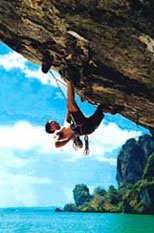Don't be Krabi; there's plenty to eat!

We overnighted in Krabi, Thailand on our way between the Andaman coast of Thailand and Vietnam. It's a port city without too much to offer travelers aside from cheap accomodation (we stayed at the "city hotel" which was a very good value), and a good airport. However, we arrived off the longtail boat (astoundingly loud narrow wooden motorboats, which have much more bark than bite (they're slow!)) hungry, so we struck out to find a place to eat. As we walked along the waterfront, we found an excellent option!
Think medium sized parking lot (by American standards) with about 100 hot dog stand carts lined up in three rows. Between and outside these rows are many, many folding tables and cheap plastic chairs. Here, they're not selling hot dogs. Oh no. Some stands just sell one item, such as Tiffany's favorite dessert, fresh mango with sweet sticky rice. Other stands, only slightly larger, offer a full Thai menu that's bigger than the Red Robin's menu! Most dishes are under $1, unless you order giant prawns or something else really unusual.
As we walked around, we heard a now familiar sound ... Thunk - squish - Thunk -squish - Thunk - squish ... in rapid sucession.~> read more
This is the sound of green papaya salad (which has no leafy greens). The green papaya itself is similar to cucumber cut in long strings, but it's mixed with fish sauce (better than it sounds, it's used for salty flavor), a few dried shrimp, chilies, lime juice, palm sugar, crushed peanuts, tomatoes, and a longer, zestier version of the green bean called "snake bean" in english. It's all mixed up in the proper order with a careful touch in a large sort of mortar and pestle, the pestle made of wood and the mortar (which is the bowl) made of clay, like a flower pot with a gently rounded shape. As the salad is mixed, a spoon is used to pull up the wet mixture from the bottom (creating the squish sound) and the pestle is then Thunk-ed back down.
We gravitated toward this sound (we love the salad), and saw that the woman making the salads (and sounds) was as well-worn as her mortar and pestle. I asked her for a som tam (green papaya salad) using the thai words, perhaps with miserable pronunciation. She knew what I wanted. I pointed to the large jar of chilies, held up three fingers. The seasoned salad-maker raised an eyebrow. This is one of the spiciest thai dishes, but most farang (westerners) would be challenged by just 1 of these "mouse dropping chilies" which have a fire as big as they are small. She could see I knew what I was ordering, and tossed them in. She gave them 10 solid mashes as I was watching, which caused me to rethink my choice of "3" chilies, since we had mashed them far more gently in our cooking class! I also pointed to the dime-sized dry shrimp, and made a small pinch with my hand to show her I just wanted a little (too many = too fishy for me). Beyond these instructions, I let her work her magic with the recipe and touch of the pestle.
We were directed to take some flimsy seats at a flimsy table on the sidewalk. A few minutes later, my som tam was delivered. I took a bite. Western food doesn't often combine amazing freshness (as in a salad straight from the farmer's market) with fiery hot spice, but it's become one of my favorite things. Three chilies pounded hard produced devlish heat, but I loved it! This was the best som tam I've had yet, and we've had it everywhere we've been from Bangkok south. Only one thing could pair with this explosive salad, and that's an ice cold beer.
Fearing the worst, we asked if beer was available. Of course! What tiny 1-entree food stand on the sidewalk wouldn't have it? Furthermore, it came in 650ml bottles (nearly two cans worth) and was some of the coldest beer we've had in Asia. It's hard to get really cold beer over here, since refrigerator space is at a premium, if the establishment even has one. How they can get frost on the outside of the bottle at a sidewalk place is beyond me; perhaps dry ice is the secret. In any case, we didn't have just one beer to cool down those chilies, and when we were finished, we wandered back to our hotel room more than satisfied with our culinary experience on the street.






